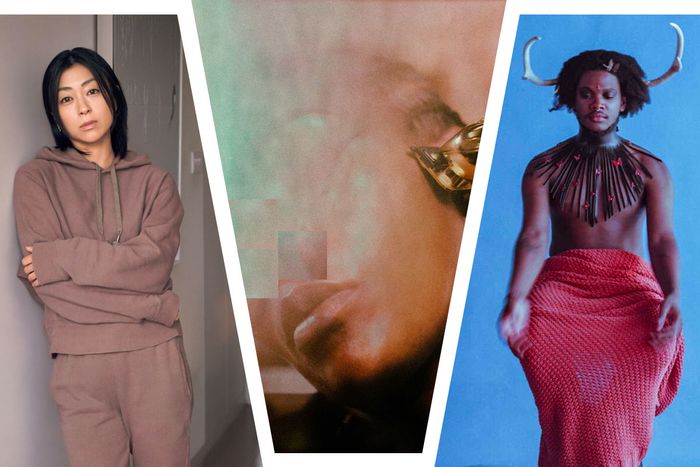
In 2022, the destruction of gender that grandpas all over the world were worried about finally made it to the top of the pop charts. Kind of. Sam Smith and Kim Petras’s “Unholy” reached number one on the Hot 100, making them the first openly non-cisgender artists to accomplish this goal — with Smith the first non-binary person and Petras the first trans-woman. And yet, it’s a difficult song to get excited about. For all its success in the “representation wins” category, “Unholy” is still ultimately about a straight dude. “Mommy don’t know daddy’s getting hot, at the body shop, doing something unholy,” booms the chorus. The most “unholy” act that two queer artists could come up with is a straight man cheating on his wife. It’s impressively un-tantalizing, the most basic kind of infraction. Is this truly the best gender transgression we have to offer right now?
As it turns out, no. Some of the most provoking, mind-bending, and downright fun albums of the year reflected their artists’ lack of faith in the gender binary by transgressing other binaries: language, genre, the divide between the singular and the multiple. They reflected anger, malaise, or withdrawal from typical ideas of gender. The music wasn’t interesting because the artists themselves served as representation, but because of each album’s individuality.
Of any record to tackle gender this year, Shamir’s Heterosexuality is the most direct. The song titles largely read like units in a queer studies class (“Gay Agenda,” “Cisgender,” “Abomination,” and “Reproductive”) or, in the case of “Cold Brew,” in-jokes within the queer community about what queer is. Yet, what could seem like a practice in surface-deep irony (queer artist names album Heterosexuality, yuck yuck) or academia is something more bracing, and, paradoxically, both simpler and more difficult.
Take “Cisgender,” the album’s second track. Its lyrics are almost comically forthright. “I am not cisgender. I am not binary trans,” Shamir sings on the chorus. “I don’t wanna be a girl, I don’t wanna be a man.” There’s little poetry to these lyrics, and that’s by design. Shamir is displaying himself in as simple a manner as possible so that there can be as little confusion on the part of the cisgender audience as possible. And yet, he sings the song in a haunted whine, backed by guitars, as if saying, “This is the easiest to understand version of my gender possible but the emotion that accompanies rendering myself this way is torturous.” When the chorus ends with “And you can take it or leave it, or you can just stay back,” it’s a plea. He’s made himself legible for your consumption, so just don’t hurt him. Shamir sings the song like a wounded animal, a reflection of the album cover in which he is clad in antlers. By the end, it is essentially functioning as a rock aria. “Stay back,” he moans, in a pained falsetto over fuzzed-out guitars and drums.
The pained plea of “Cisgender” is immediately contrasted with “Abomination.” “I’m just a faggot who looks like a maggot because I’m always with the shits,” he spits. “I’ll keep my foot on your neck, and don’t you forget, can’t trust the government to change shit.” The dichotomy is the point. Heterosexuality is not about “heterosexuality” — it’s aimed at it. The album has been accused by some as over-negative and potentially suicidal. (“Burial is their job, not ours,” declared Pitchfork upon its release.) But Heterosexuality is not about wallowing, it’s about claiming space. When Shamir alights upon multiple genres, modes of expression, and ways of being, he isn’t giving into the sadness, he’s forcing the effects of heterosexuality to provide catharsis.
Yet, the directness of Shamir is not suited to all artists, and it would be a shame to consider those who engage with queerness head on to be the only purveyors of this kind of gender complexity. On Japanese pop star Hikaru Utada’s Bad Mode, songs like “Somewhere Near Marseilles” display a stunning amount of both simplicity and excess — the song has an unaffected vocal clarity, yet runs for almost 12 minutes. Notably, it is the singer’s first album to feature both Japanese and English lyrics, as well as being the first album they’ve released since coming out as nonbinary. The songs themselves are titled sometimes in English and sometimes in Japanese. One (“Face My Fears”) has both a Japanese and English version.
“I’ve definitely found you take on a different identity when you switch between languages when you’re multilingual,” Utada told NPR. “I’m not sure why I felt more feminine in [English]. Maybe because I’m just more comfortable with [myself now] and I’m more aware of who I am.” The bilingual nature of the album is of a piece with the freedom that Utada is building for themselves within the gender system.
This liberation is also reflected in the choice to opt for a completely electronic production. Utada’s way of existing throughout Bad Mode is to operate within a constructed world — unburdened by associations that sounds that pianos or guitars may invoke. It’s a reminder of what SOPHIE knew back in 2015, when the goal of her electronic masterworks on the album Product, according to a New York Times interview, was, “to make it essentially about shapes and colors and feelings, rather than this pre-existing musical language.”
On Bad Mode, Utada doesn’t sing about gender, they sing about love, connection, and loneliness. Unlike Shamir, the text of their album is not a direct address of identity. What their self-synthesized, bilingual world does provide them with is the freedom to fully express themselves. Here, the gender is not the text, but the context.
On the opposite end of that spectrum is Leikeli47’s Shape Up, one of the year’s most interesting and spiky rap albums. On it, she assumes a multiplicity of gender expressions and identities. Leikeli47 is an elusive figure, constantly wearing a ski mask to be completely free of a “real” identity. With Shape Up, this vagueness of identity provides her the ability to play whoever she wants, however she wants to. On songs like “LL Cool J” and “Free to Love,” she replaces her own name and pronoun with a beep and an “Uh,” respectively. This flexibility lets her fluctuate wildly between personas, without any of them feeling like a character. For example, within one four-song run, she sings a breakup song to her “baby mama” (“Free To Love”), declares herself “the man” (“BITM”), sweetly seduces her man using sports metaphors (“Baseball”), and brags “This is my pussy, I can do what I want/Hm, I’m a big girl now” (“Carry Anne”). These songs showcase a facility for jumping around with gender and sexuality; there’s an innate tension that Leikeli47 toys with in putting a ballroom track like “BITM” next to “Baseball,” which is all coy heteronormativity. It’s a remarkable show of confidence to bounce around like she does.
What’s most exciting is not simply that Leikeli47 tries her hand at all of it, but that none of the performances feel like a bit. By removing her actual self from any narrative around her music via her mask, Leikeli47 is able to use Shape Up as an actual display of her talent and of all the personality traits, including modes of gender, she can inhabit. She is not like Orville Peck, a masked artist whose “gay cowboy” persona is a near-constant present to the point where image is as important as artistry, if not more important, as his work. Leikeli47’s mask is an intentional withdrawal that allows her to bounce between personas, genre, and gender definitions. When she speaks about the mask, she speaks of it in similar terms to Utada’s way of talking about electronic music and language. “I feel like the Dark Knight, or one of those superheroes, or Superman… the mask, it represents freedom,” Leikeli47 told Vibe.
Meanwhile, if there’s a piece of music that felt more “free” in 2022 than Mykki Blanco’s Stay Close to Music, I haven’t heard it. The rapper created a balls-to-the-wall auteurist fantasy, blending rock and rap and pop and spoken word with a near constant array of guests. Part of what’s fascinating about the way Stay Close to Music functions is how the features seem not like evocations of the artists singing them but like tools that Blanco uses to extrapolate their own mental state. Artists like MNEK, Anohni, and Diana Gordon rattle around in their own brains and over the tracks, while Blanco adopts so many different voices themselves it’s sometimes difficult to tell who, exactly, is singing/rapping/speaking.
The different personas of Mykki Blanco existing all in one space is the central vision of Stay Close to Music, and it takes on many different shapes. On the album cover, what looks like two different Mykki Blancos with wings exist side by side: one lackadaisical one laying on the bed in pants, and one in a skirt, flying about the room and smiling. Musically, their multiplicity is shown through a diversity of topics, sometimes sweetly praising the love of their man (“French Lessons”) or reflecting on how “I should have never dated white men” (“Steps”) or advocating for Black trans women’s inclusion in feminism (“Your Feminism Is Not My Feminism”).
The drug-addled world of Mykki Blanco is yet another example of the ethos of the larger group: Rather than play in expected territory, with cleanly defined genre and language markers, they start from the bottom and create worlds to themselves. When gender enters the equation, it’s thought of in the same way: not as a matter of representation, but as a tool to play with. Each of these albums point to a path away from “representation” being a totalizing force in discussions of how gender is broken down in music. Instead of existing solely as an identity for the artist in question to inhabit, the destruction of binary gender ideas can be a prerogative. Identity can only go so far. These artists show us how non-binary ideas of gender can be used as verbs, something to do, not just something to be.


